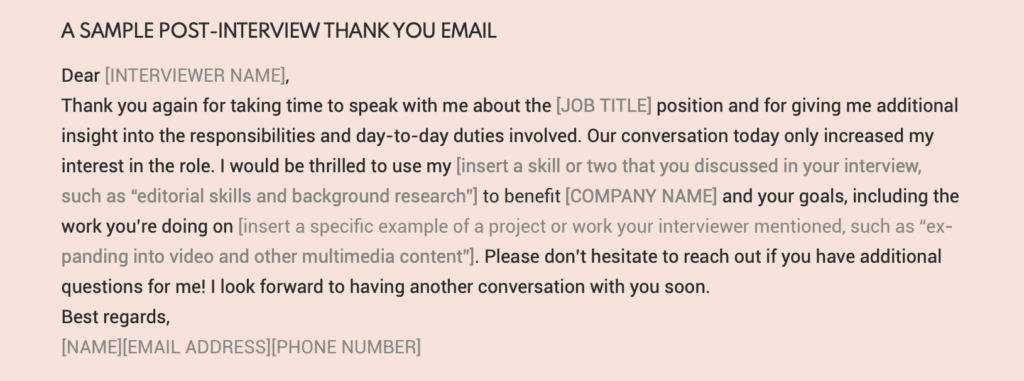When the interview is over, it’s never really over. Sending a thank you note after an interview can really set you apart from other job applicants, however, what you say in that note can even influence hiring decisions. According to a survey by Accountemps, 80% of hiring managers find post interview thank you notes helpful when reviewing candidates. Yet, only a fourth of hiring managers ever receive thank you notes from applicants, meaning taking 10 minutes to compose such a note to the interviewer is one of the easiest things you can do to set yourself apart.
By sending a thoughtful thank you note, you are signaling you’re a serious candidate who respects the interview process and all the time and effort that goes into it.
What to say in a thank you note:
+ A greeting that details your appreciation (the “thank you” part).
+ Something specific about the interview or items discussed. If you promised to follow up on an answer or additional thoughts on a topic, be sure to do so in this section.
+ Why you see this role as an exciting opportunity
+ A brief explanation of why you’d be a good fit for the job. This is your chance to sell yourself – don’t be shy!
+ Next steps and your contact information
Mistakes to avoid in a thank you:
+ Making it generic or identical to the thank you’s you sent to others you interviewed with at the company
+ Confirm that you have the company and interviewers name correct
+ Keep it concise — no more than a page. This should read more like a memo
+ Sending too soon or too late. Be sure to reflect and put thought into the note, but don’t take too long as the interviewer may feel you aren’t eager or really interested.
Occasionally, you may want to go old school and send the note via snail-mail (however, 94% of HR managers say it’s appropriate to send a thank you note via email) . But that largely depends on the culture of the company you you’re applying to. If they emailed you, you’re fine emailing. If they reached out by phone or mail, consider putting your note in the post.
Any way you choose to send your note, it is important that you only send one to each person following each interview round. You don’t want to overwhelm or inundate the interviewer with multiple thank you’s.
The Post- Interview Thank you Template
Here is an email template of a short and sweet post-interview thank you note.

A Final Thought
If you don’t hear back right away, that is okay. We recommend waiting 5-7 days before following up. You can reply to your original email expressing interest one more time. If there still isn’t a response or feedback within the time they promised, you may want to consider taking this as a red flag about the workplace culture you may be dealing with.
Respect and communication are important from the start and the employer is not the only one interviewing (Avoid Job Regret and Interview Your Future Employer) . It is just as critical that you take note of what they say – and don’t say – during the interview process and reflect on your holistic experience before accepting an offer.







